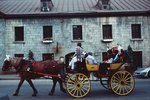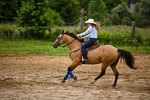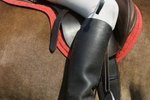A saddle provides the connection between the horse and the rider. The seat must fit the rider, both for comfort and for security’s sake. If the saddle gullet does not fit the horse correctly, the saddle will slip or roll, as well as potentially cause discomfort for the horse when the rider is seated.
Parts of a Western Saddle
Every saddle, no matter the style, is built around a frame called a tree. The tree is composed of four parts: bars, cantle, fork and seat. The fork frames the angle of the saddle over the horse’s withers. It is connected to the cantle, the framework of the rear of the seat, by the bars. The angle of the bars determines the height and width of the gullet, the channel that runs the length of the underside of the saddle, over the horse’s spine.
The saddle is attached to the horse by means of the rigging, the girth and the rings that connect the girth to the saddle. Some saddles have more than one girth. The type of rigging used on a saddle has an effect on where it is placed on the horse’s back. That is, the location and number of girths securing the saddle determine how close the saddle rests to the withers and the back of the forelegs.
Bars and Gullet Width
The angle of the gullet determines the proximity of the saddle to the top of the horse’s withers. The bars control the angle of the gullet and the channel. Their angle determines the amount of contact the saddle has with the horse’s back. They must make contact with the horse’s back through the entire length of the saddle to keep the saddle from rocking and creating pressure on the horse’s withers, and to distribute the rider’s weight effectively.
Bars come in five standard angles, and a saddlery can provide bars with custom angles. Check the bar angle and gullet measurement for your saddle with the saddle manufacturer, as measurements may vary.
- Quarter horse bar: Gullet width from 5.75 to 6 inches, for narrow-bodied horses
- Semi-quarter horse bar: Gullet width 6 inches
- Full quarter horse bar: Gullet width 6.25 to 6.5 inches, for wide-bodied horses with flat withers
- Extra-wide quarter horse bars: Gullet width 6.75 to 7 inches
- Arabian bars: Gullet width 6.25 to 6.75 inches, with a lower pitch than quarter horse bars
Measuring Gullet Height and Width
Stand your horse on a level surface, tied if necessary to keep him still. Place the saddle directly on his back, without using a saddle pad. Ensure that the saddle is level from front to back and from side to side.
Look at the saddle’s position from the front. The saddle gullet should span the withers, resting on the withers about 2 inches below their highest point and leaving a gap between the top of the withers and the bottom of the saddle. Place your hand into the space between the saddle and your horse’s wither, using your fingers to measure the vertical space.
The gap should fit no more than two fingers to two and a half fingers. If three or more fingers fit, the gullet is too narrow. If fewer than two fingers fit, the gullet is too wide. Slide your hand under the saddle and along the gullet to determine whether the pressure from the bars is evenly applied throughout.
The Importance of Accurate Gullet Measurements
The gullet is a critical saddle measurement. An inadequate gullet will cause the saddle to rest on the horse’s spine and pinch his withers. Such a placement will result in pressure sores from the horse’s spine rubbing against the saddle pad. A gullet that is too wide will allow the rider’s weight to rest on the spinous processes, the bony protrusions of your horse’s spine, potentially causing him pain.
References
Resources
Photo Credits
-
LisaIson/iStock/Getty Images





